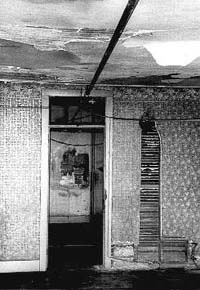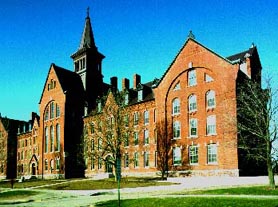

|
|
|
|
|
|
|
|
|
|
|
Fire again played a part in the history of Old Mill when lightning struck on 1918. By the time it was extinguished, the blaze had severely damaged much of South College, especially its roof and fourth floor. As Converse Hall was complete and fraternities had become popular, Old Mill was no longer needed to provide dormitory space for the University students, and as a result, the entire fourth floor was closed off, the dormers were removed, and the third floor dormitory space was converted into classrooms, offices and a laboratory. Right: Former student dormitory room, Old Mill attic, north wing, looking east. Note the transom window above the door and the flue hole for a stove pipe. (Photo: T. Visser, 1988.) After being closed for several years during World War II, seventeen rooms in the south end of Old Mill were converted back to dormitory space to house women students.
Right: View of Old Mill looking northeast,
circa 1950. (UVM Archives) In 1957, the Burlington architectural firm of Freeman, French, Freeman designed the International style Lafayette Hall . This utilitarian structure that was connected to Old Mill by a second story enclosed bridge, provided the University of Vermont with much-needed classroom space for nearly four decades.
Coinciding with the construction of Lafayette Hall as a classroom annex, the interior of Old Mill was substantially altered in 1958. The entrances on the north and south ends were blocked off and partitions were removed to create two large first floor lecture halls. For the first time all the rooms on each floor were connected by long corridors running the entire length of the building. Numerous partitions divided the areas west of the corridors into small offices and fireproof stairs and restrooms were added on the east side.
First floor lecture room 109, looking
south, with Geography Department maps. The historical significance of Old Mill was recognized in 1975 when it was listed on the National Register of Historic Places as a contributing building within the University Green Historic District.
After several years of careful planning, in 1995, the University of Vermont launched the latest major renovation of the Old Mill building.
UVM Historic Preservation Program graduate
student, Will Bentley, '92, removing paint layers to document
the historic decorative finish designs in John Dewey Lounge.
Photo: T. Visser, 1991. Completed in May 1997 at a cost of 17 million dollars, Old Mill has been transformed into an up-to-date educational facility through the generosity of the people of the State of Vermont and the gifts of alumni, parents and friends of the UVM. The interior was entirely redone with new offices, classrooms, and meeting spaces. Lafayette Hall was transformed into an attractive four-story brick structure that is now the University's largest and most technologically advanced classroom building. It is linked to Old Mill by the Old Mill Annex, a modern three-story addition with general purpose clssrooms, a computer classroom, and various service facilities. The main block of Old Mill now houses the Geography Department, Economics Department, Women Studies Program, English Department, the Center for Holocaust Studies, the Humanities Center, the Political Science Department, the Area and International Studies Office, and the ALANA Studies Program.
Right: Old Mill, view looking northeast
from the UVM Green. Photo: T. Visser, 1997.) |
 Old
Mill (3 of 3)
Old
Mill (3 of 3) By
the early 1950s, however, the growing number of students, cramped
conditions, and concerns for fire safety in Old Mill prompted
the University to plan another major renovation.
By
the early 1950s, however, the growing number of students, cramped
conditions, and concerns for fire safety in Old Mill prompted
the University to plan another major renovation. Right: Lafayette Hall, view looking southeast.
(Photo: T. Visser, 1988.)
Right: Lafayette Hall, view looking southeast.
(Photo: T. Visser, 1988.)
 Additional
national recognition came in 1991, when the United States Postal
Service commemorated the two hundredth anniversary of the founding
of the University of Vermont with a special post card featuring
Old Mill (right).
Additional
national recognition came in 1991, when the United States Postal
Service commemorated the two hundredth anniversary of the founding
of the University of Vermont with a special post card featuring
Old Mill (right).
 With
the exterior of the historic main block carefully restored to
its 1880s appearance with the historic paint scheme on the tower
and trim and with replicas of the former dormers and chimneys
installed on the roof, Old Mill conveys a strong message of respect
for past achievements as it points the way towards an exciting
future for the University of Vermont.
With
the exterior of the historic main block carefully restored to
its 1880s appearance with the historic paint scheme on the tower
and trim and with replicas of the former dormers and chimneys
installed on the roof, Old Mill conveys a strong message of respect
for past achievements as it points the way towards an exciting
future for the University of Vermont.